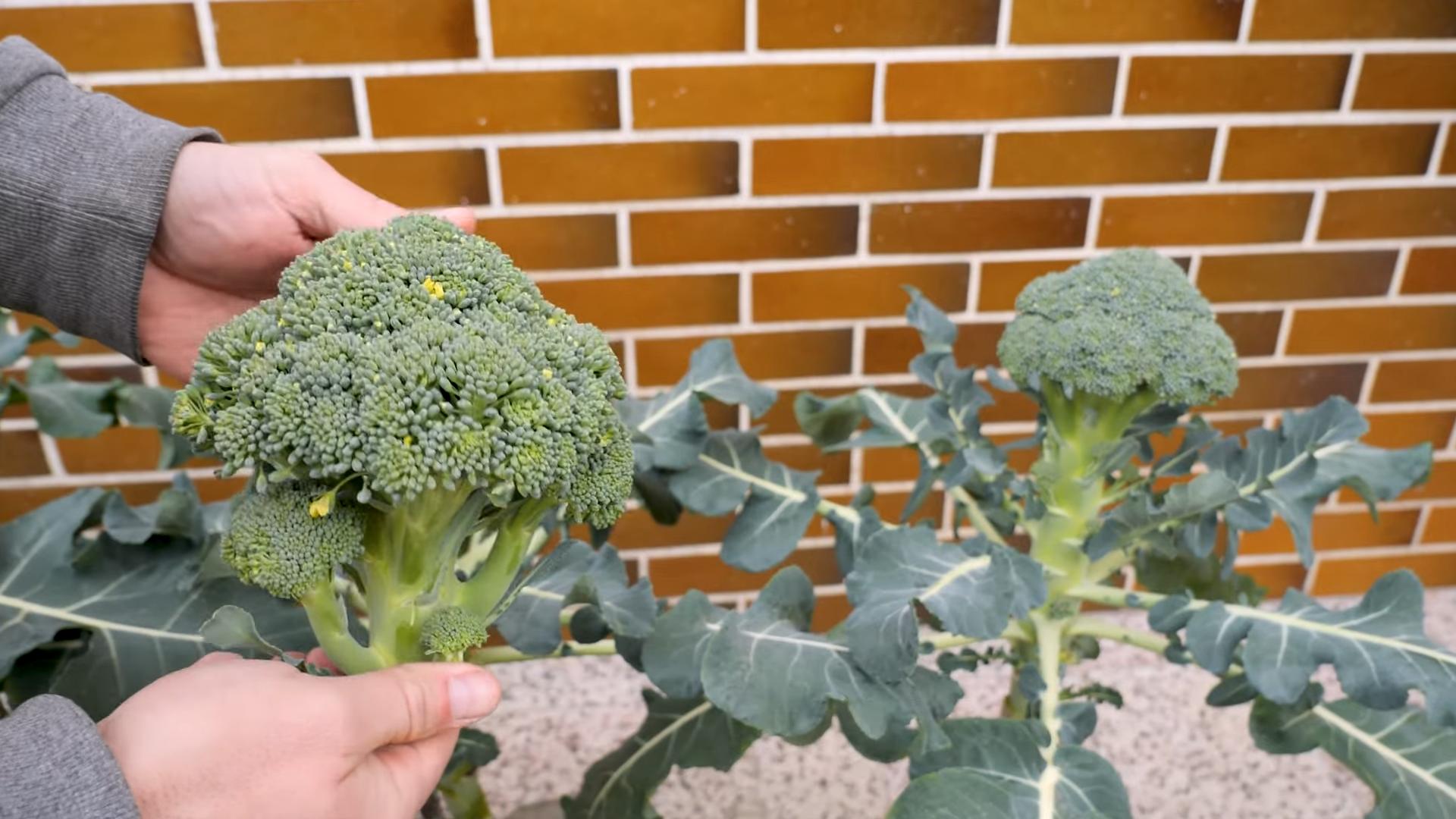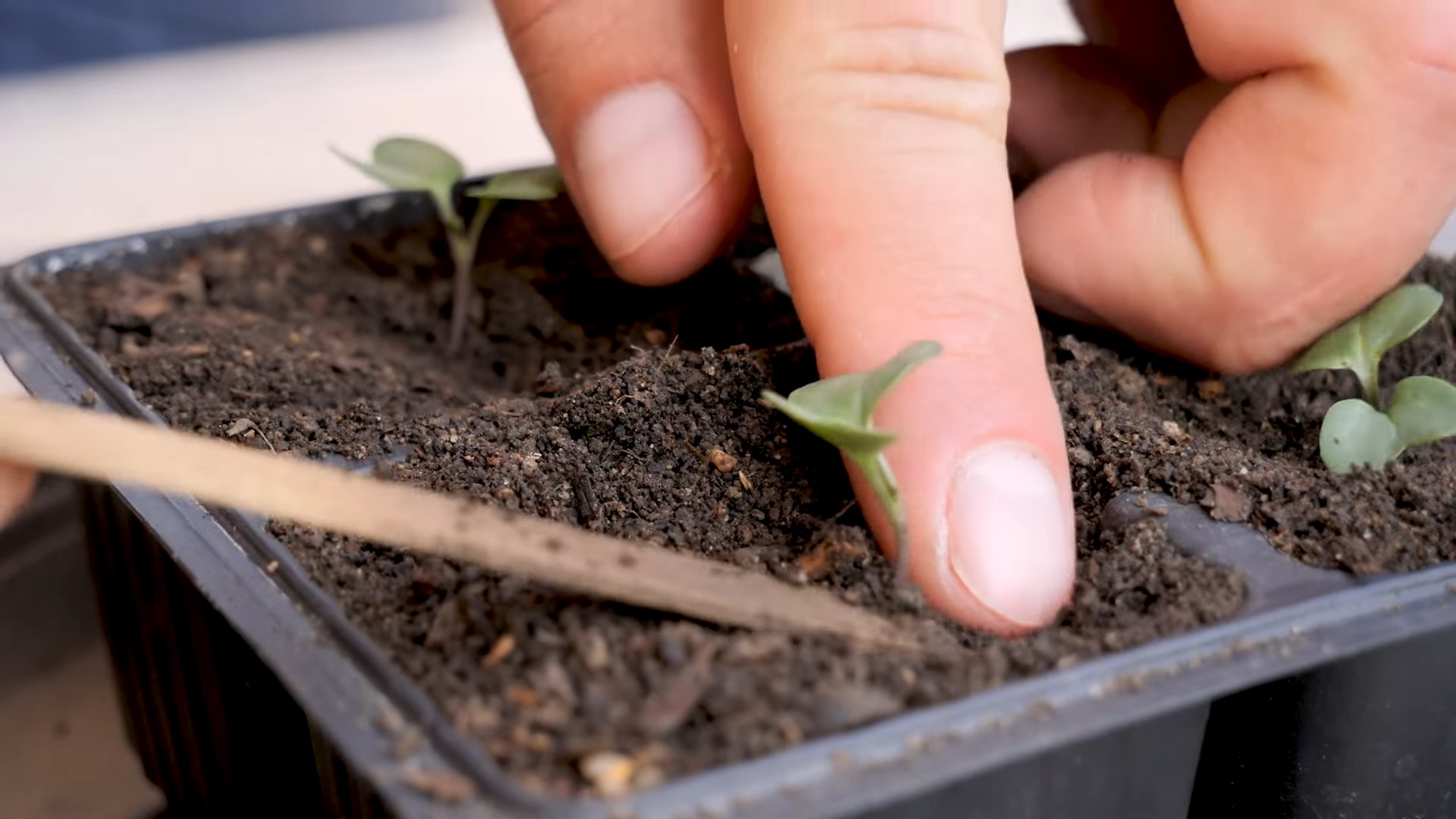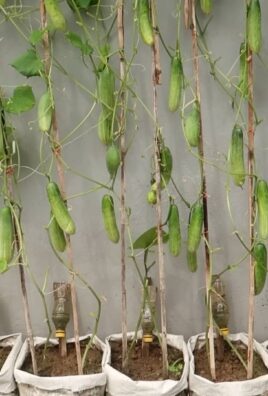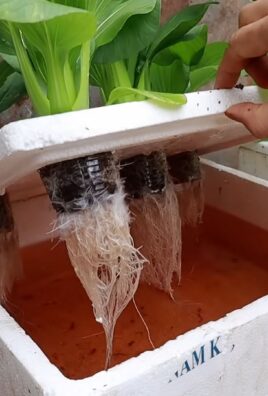Planting and Harvesting Broccoli can seem daunting, but trust me, with a few simple tricks, you’ll be enjoying homegrown broccoli in no time! I remember my first attempt – a scraggly, pathetic excuse for a vegetable. But don’t let that scare you! We’re going to dive into some easy DIY hacks that will transform your garden into a broccoli-producing powerhouse.
Broccoli, a member of the brassica family, has a rich history dating back to the Roman Empire. It was considered a prized vegetable, and its cultivation spread throughout Europe. Today, it’s a staple in healthy diets worldwide, packed with vitamins and antioxidants. But why settle for store-bought when you can have fresher, tastier broccoli right from your backyard?
Let’s face it, grocery store broccoli can be expensive and often lacks the vibrant flavor of freshly harvested produce. Plus, knowing exactly where your food comes from and how it’s grown is incredibly rewarding. This DIY guide will equip you with the knowledge to successfully navigate the entire process of planting and harvesting broccoli, from seed to table. We’ll cover everything from choosing the right varieties to preventing common pests and diseases. Get ready to impress your friends and family with your green thumb – let’s get started!

DIY: From Seed to Supper – Growing Your Own Broccoli!
Okay, let’s get our hands dirty! I’m going to walk you through everything you need to know to grow your own delicious broccoli, right from seed. It might seem intimidating at first, but trust me, it’s incredibly rewarding to harvest your own veggies. We’ll cover starting seeds, transplanting, caring for your plants, and finally, harvesting that beautiful broccoli head. Let’s get started!
Getting Started: Seeds, Soil, and Sunshine
Before we even think about planting, we need to gather our supplies and understand the basics. Broccoli thrives in cool weather, so timing is key.
* Timing is Everything: Broccoli is a cool-season crop. For a spring harvest, start seeds indoors 6-8 weeks before the last expected frost. For a fall harvest, start seeds outdoors in mid-summer. Check your local frost dates!
* Seed Selection: Choose a broccoli variety that suits your climate and preferences. Some popular choices include ‘Waltham 29’, ‘DiCicco’, and ‘Calabrese’. I personally love ‘DiCicco’ because it produces smaller, more manageable heads and side shoots.
* Soil Matters: Broccoli needs well-draining, fertile soil with a pH between 6.0 and 7.0. Amend your soil with compost or well-rotted manure to improve drainage and fertility.
* Sunlight is Crucial: Broccoli needs at least 6 hours of sunlight per day. Choose a sunny location for your garden bed.
Starting Your Broccoli Seeds Indoors
Starting seeds indoors gives you a head start, especially if you live in an area with a short growing season.
1. Gather Your Supplies: You’ll need seed starting trays or small pots, seed starting mix, broccoli seeds, a spray bottle, and a grow light (optional, but highly recommended).
2. Prepare the Seed Starting Mix: Moisten the seed starting mix with water until it’s damp but not soggy.
3. Sow the Seeds: Fill the seed starting trays or pots with the moistened mix. Sow the broccoli seeds about 1/4 inch deep, planting 2-3 seeds per cell or pot.
4. Cover and Water: Gently cover the seeds with more seed starting mix and lightly water with a spray bottle.
5. Provide Warmth and Light: Place the seed starting trays in a warm location (around 70-75°F) and under a grow light. If you don’t have a grow light, place them near a sunny window, rotating the trays regularly to prevent the seedlings from leaning towards the light.
6. Keep the Soil Moist: Keep the seed starting mix consistently moist, but not waterlogged. Water gently with a spray bottle as needed.
7. Thin the Seedlings: Once the seedlings have emerged and have their first true leaves (the second set of leaves), thin them to one seedling per cell or pot. Choose the strongest, healthiest seedling and snip off the others at the soil line. Don’t pull them out, as this can disturb the roots of the remaining seedling.
Transplanting Your Broccoli Seedlings
Once your seedlings have developed several sets of true leaves and the weather has warmed up, it’s time to transplant them into your garden.
1. Harden Off the Seedlings: Before transplanting, you need to “harden off” the seedlings. This means gradually exposing them to outdoor conditions to acclimate them to the sun, wind, and temperature changes. Start by placing the seedlings outdoors in a sheltered location for a few hours each day, gradually increasing the amount of time they spend outdoors over the course of a week.
2. Prepare the Garden Bed: Choose a sunny location in your garden with well-draining soil. Amend the soil with compost or well-rotted manure to improve fertility.
3. Transplant the Seedlings: Dig holes that are slightly larger than the root balls of the seedlings. Gently remove the seedlings from their trays or pots and place them in the holes. Space the seedlings about 18-24 inches apart.
4. Water Thoroughly: Water the seedlings thoroughly after transplanting.
5. Mulch Around the Plants: Apply a layer of mulch around the plants to help retain moisture, suppress weeds, and regulate soil temperature. I like to use straw or shredded leaves.
Caring for Your Broccoli Plants
Now that your broccoli plants are in the ground, it’s important to provide them with the care they need to thrive.
* Watering: Broccoli needs consistent moisture, especially during hot, dry weather. Water deeply and regularly, aiming for about 1-1.5 inches of water per week. Avoid overhead watering, as this can promote fungal diseases.
* Fertilizing: Broccoli is a heavy feeder, so it benefits from regular fertilization. Apply a balanced fertilizer every 2-3 weeks, following the instructions on the fertilizer label. You can also side-dress with compost or well-rotted manure.
* Weeding: Keep the garden bed free of weeds, as they can compete with the broccoli plants for nutrients and water. Hand-pull weeds regularly or use a hoe to cultivate the soil.
* Pest Control: Broccoli is susceptible to several pests, including cabbage worms, aphids, and flea beetles. Inspect your plants regularly for signs of pests and take action as needed.
* Cabbage Worms: These green caterpillars can quickly devour broccoli leaves. Hand-pick them off the plants or use a biological insecticide like Bacillus thuringiensis (Bt).
* Aphids: These small, sap-sucking insects can weaken broccoli plants. Spray them off with a strong stream of water or use insecticidal soap.
* Flea Beetles: These tiny beetles can create small holes in broccoli leaves. Cover the plants with row covers to prevent flea beetles from reaching them.
* Disease Prevention: Broccoli can be affected by several fungal diseases, such as clubroot and black rot. To prevent these diseases, choose disease-resistant varieties, practice crop rotation, and avoid overhead watering.
Harvesting Your Broccoli
The moment we’ve all been waiting for! Knowing when and how to harvest your broccoli is crucial for getting the best flavor and yield.
1. Timing is Key: Harvest broccoli when the central head is firm, tight, and a deep green color. The individual florets should be tightly closed. If the florets start to open and turn yellow, it’s time to harvest immediately.
2. Cut the Head: Use a sharp knife to cut the central head from the plant, leaving about 4-6 inches of stem.
3. Encourage Side Shoots: After harvesting the central head, the plant will produce side shoots. These smaller heads can be harvested as they mature.
4. Harvest Side Shoots Regularly: Harvest the side shoots regularly to encourage continued production.
5. Enjoy Your Harvest: Wash your freshly harvested broccoli and enjoy it raw, steamed, roasted, or in your favorite recipes!
Troubleshooting Common Broccoli Problems
Even with the best care, you might encounter some problems while growing broccoli. Here are a few common issues and how to address them:
* Buttoning: This occurs when the broccoli head forms prematurely and remains small. It’s often caused by stress, such as cold temperatures, lack of water, or poor soil fertility. To prevent buttoning, provide consistent moisture, fertilize regularly, and protect plants from extreme temperatures.
* Bolting: This happens when the broccoli plant flowers prematurely, usually due to hot weather. Once a plant bolts, the head becomes bitter and inedible. To prevent bolting, choose heat-tolerant varieties and plant broccoli at the right time of year.
* Yellowing Leaves: Yellowing leaves can be a sign of nutrient deficiency, disease, or pest infestation. Check the soil pH and nutrient levels, inspect the plants for pests and diseases, and take action as needed.
Extending Your Broccoli Harvest
Want to keep the broccoli coming? Here are a few tips for extending your harvest:
* Succession Planting: Plant broccoli seeds every 2-3 weeks to ensure a continuous harvest throughout the growing season.
* Choose Bolt-Resistant Varieties: Select broccoli varieties that are known to be more resistant to bolting in hot weather.
* Provide Shade: During hot summer months, provide shade for your broccoli plants to help prevent bolting. You can use shade cloth or plant them in a location that receives afternoon shade.
Saving Broccoli Seeds (Advanced!)
If you’re feeling adventurous, you can even save your own broccoli seeds! This is a more advanced technique, but it’s a great way to preserve your favorite varieties and become more self-sufficient.
1. Choose Healthy Plants: Select healthy, vigorous broccoli plants to save seeds from.
2. Allow the Plants to Flower: Allow the plants to flower and produce seed pods.
3. Harvest the Seed Pods: Once the seed pods are dry

Conclusion
So, there you have it! Mastering the art of planting and harvesting broccoli at home is not only achievable but incredibly rewarding. From the satisfaction of nurturing a tiny seedling to the joy of harvesting your own fresh, vibrant florets, this DIY trick offers a connection to your food that you simply can’t get from store-bought produce.
Why is this a must-try? Because beyond the cost savings and the superior flavor of homegrown broccoli, you’re gaining control over the entire process. You know exactly what goes into your food – no mystery pesticides or questionable growing practices. You’re also reducing your carbon footprint by eliminating the transportation and packaging associated with commercially grown broccoli. Plus, let’s be honest, there’s a certain pride that comes with serving a dish featuring broccoli you grew yourself!
But the journey doesn’t end with the basic method. Feel free to experiment! Try different varieties of broccoli, such as Romanesco or purple sprouting broccoli, to add visual appeal and unique flavors to your plate. Consider companion planting with herbs like rosemary or thyme to deter pests naturally and enhance the flavor of your broccoli. You can also adjust the planting schedule based on your local climate to extend your harvest season. For those with limited space, dwarf varieties of broccoli are perfect for container gardening.
Don’t be intimidated if you’re a beginner gardener. Broccoli is a relatively forgiving crop, and with a little patience and attention, you’ll be enjoying a bountiful harvest in no time. Remember to pay close attention to soil quality, watering needs, and pest control, and you’ll be well on your way to success.
We wholeheartedly encourage you to give this DIY trick a try. Imagine the delicious broccoli dishes you can create – from simple steamed broccoli with lemon to hearty broccoli cheddar soup or roasted broccoli with garlic and parmesan. The possibilities are endless!
And most importantly, we want to hear about your experience! Share your tips, tricks, and triumphs in the comments below. Let us know what varieties you’ve tried, what challenges you’ve faced, and what delicious recipes you’ve created with your homegrown broccoli. Your insights will help other aspiring gardeners on their own broccoli-growing journey. Let’s build a community of broccoli enthusiasts and share the joy of growing our own food! So, grab your seeds, get your hands dirty, and get ready to enjoy the freshest, most flavorful broccoli you’ve ever tasted. Happy gardening!
Frequently Asked Questions (FAQ)
Q: What is the best time of year to plant broccoli?
A: The best time to plant broccoli depends on your climate. In areas with mild winters, you can plant broccoli in the fall for a winter or early spring harvest. In colder climates, start seeds indoors 6-8 weeks before the last expected frost and transplant them outdoors in the spring. You can also plant a second crop in late summer for a fall harvest. The key is to avoid planting during the hottest part of the summer, as high temperatures can cause broccoli to bolt (go to seed).
Q: How much sunlight does broccoli need?
A: Broccoli needs at least 6 hours of direct sunlight per day to thrive. Choose a sunny location in your garden that receives ample sunlight throughout the day. If you’re growing broccoli in containers, make sure to place them in a sunny spot. Insufficient sunlight can result in leggy plants with small heads.
Q: What kind of soil is best for growing broccoli?
A: Broccoli prefers well-drained, fertile soil that is rich in organic matter. The ideal soil pH is between 6.0 and 7.0. Before planting, amend the soil with compost or well-rotted manure to improve its fertility and drainage. You can also add a balanced fertilizer to provide essential nutrients.
Q: How often should I water broccoli?
A: Broccoli needs consistent moisture to grow properly. Water deeply and regularly, especially during dry periods. Aim to keep the soil consistently moist but not waterlogged. Mulching around the plants can help retain moisture and suppress weeds. Check the soil moisture regularly and adjust your watering schedule accordingly.
Q: How do I know when broccoli is ready to harvest?
A: Broccoli is ready to harvest when the central head is firm, tight, and a deep green color. The individual florets should be tightly closed. If the florets start to open and turn yellow, it’s a sign that the broccoli is overripe. Use a sharp knife to cut the head from the plant, leaving a few inches of stem. After harvesting the main head, the plant may produce smaller side shoots that you can also harvest.
Q: What are some common pests and diseases that affect broccoli?
A: Broccoli is susceptible to several pests and diseases, including cabbage worms, aphids, flea beetles, clubroot, and black rot. To prevent pest and disease problems, practice crop rotation, use row covers to protect plants from insects, and choose disease-resistant varieties. Inspect your plants regularly for signs of pests or diseases and take appropriate action, such as handpicking pests, using insecticidal soap, or applying a fungicide.
Q: Can I grow broccoli in containers?
A: Yes, you can grow broccoli in containers, especially dwarf varieties. Choose a large container that is at least 12 inches in diameter and 12 inches deep. Use a well-draining potting mix and provide adequate sunlight and water. Fertilize regularly to provide essential nutrients. Container-grown broccoli may require more frequent watering than broccoli grown in the ground.
Q: How do I store harvested broccoli?
A: To store harvested broccoli, wrap it loosely in a damp paper towel and place it in a plastic bag in the refrigerator. Broccoli can be stored for up to a week in the refrigerator. You can also freeze broccoli for longer storage. To freeze broccoli, blanch it in boiling water for 3-5 minutes, then plunge it into ice water to stop the cooking process. Drain the broccoli thoroughly and freeze it in a single layer on a baking sheet. Once frozen, transfer the broccoli to a freezer bag or container.
Q: What are some creative ways to use homegrown broccoli?
A: The possibilities are endless! You can steam, roast, sauté, or grill broccoli. Add it to soups, salads, stir-fries, and casseroles. Make broccoli cheddar soup, broccoli slaw, or roasted broccoli with garlic and parmesan. You can even use broccoli stems in smoothies or soups. Get creative and experiment with different flavors and cooking methods to find your favorite ways to enjoy your homegrown broccoli.
Q: My broccoli plant is bolting (going to seed). What should I do?
A: Bolting is often caused by stress, such as high temperatures or inconsistent watering. Once a broccoli plant bolts, the head will become loose and the florets will start to open and turn yellow. While the broccoli may still be edible, it will likely be bitter and less flavorful. You can try harvesting the remaining florets and using them in soups or stir-fries. To prevent bolting in the future, choose heat-tolerant varieties, provide consistent watering, and avoid planting during the hottest part of the summer.




Leave a Comment